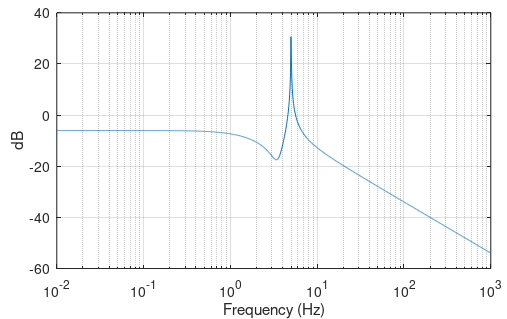Good work thus far.
First combine the two ratios with a common denominator using:
$$\frac{a}{b} + \frac{c}{d}= \frac{ad + bc}{bd}$$
Then you can determine the magnitude using the relationship for the magnitude of a complex number given as $a+jb$ is $\sqrt{a^2+b^2}$. This should clear up your remaining confusion.
The "bandwidth" then must be defined. Typically a "3 dB bandwidth" is used which refers to the half power points in the waveform (from fmin to fmax). This would be where the magnitude would be $1/\sqrt{2}$. (That choice is somewhat arbitrary, but since the frequency content extends to infinity, and getting infinitely small as it does, we need to define some sort of "cutoff". I will assume here that it is specifically when the magnitude reaches $1/\sqrt{2}$.
Additional comments on efforts made:
The OP has successfully combined the ratios, but the next step in computing the magnitude is in error. The approach is to group all the reals together noting that $\omega$ is real to complete the magnitude of a general complex number with real and imaginary components $a+jb$ to be $\sqrt{a^2+b^2}$. Note in that form that $a$ is the real component and $b$ is the imaginary component. For example, the numerator given correctly as $25+2j\omega -2\omega^2$ has real component $25-2\omega^2$ and imaginary component $2\omega$. Use these as the $a$ and $b$ in the expression I give to compute the magnitude (This is simply the cartesian distance on the complex plane). Similarly the denominator first needs to be completely multiplied out, and then group the imaginary and real components together and compute the magnitude for that.
Additional comments:
I concur with the OP's conclusion that the path I suggested above (which would then be easy to compute with MATLAB or Python if available) is quite cumbersome. Given we have the sum of the two functions, we can from superposition treat each one independently and from that make a reasonable estimate as to the maximum and minimum frequency- The OP has done this already and just needs to determine for each what the -3 dB frequency corner would be (for a 3 dB BW case, which is $1/\sqrt{2}$ in magnitude.
So given the composite function as:
$$X(\omega) = X_1(\omega) + X_2(\omega)$$
We have for $X_1(\omega)$:
$$X_1(\omega) = \frac{j\omega}{25-\omega^2}$$
$$|X_1(\omega)| = \bigg|\frac{\omega}{25-\omega^2}\bigg| \tag{1}\label{1}$$
The criteria for bandwidth was not specified, but if we state that it is when the magnitude reaches $1/\sqrt{2}$ (not relative to the max in this case since the maximum goes to infinity!), then we could solve for $\omega$ as:
$$ \bigg|\frac{\omega}{25-\omega^2}\bigg| = 1/\sqrt{2}$$
For this, the highest frequency is solved to be:
$$\omega_{hi} = \frac{1+\sqrt{51}}{\sqrt{2}} \approx 5.76$$
Note that a cosine on its own would have no bandwidth and would occupy the frequency of 5 rad/sec. However this is a cosine multiplied by a unit step function, which serves to extend it's bandwidth out to infinity going down by 1/f. The 5.76 radians/sec point is where the magnitude in frequency has dropped to $1/\sqrt{2}$.
And for $X_2(\omega)$:
$$X_2(\omega) = \frac{1}{j\omega+2}$$
$$|X_2(\omega)| = \frac{1}{\sqrt{\omega^2+4}}\tag{2}\label{2}$$
This has a frequency that extends to DC (the magnitude at DC is 0.5), and thus the lowest frequency = 0. Note that at the high frequency determined from the cosine of $\omega= 5.76$, $|X_2(\omega)| = 0.164$. To be accurate in determining the frequency for a specific magnitude such as $1/\sqrt{2}$, we would have to account for the magnitude from both $|X_1(\omega)|$ and $|X_2(\omega)|$ in which case I can't imagine the requested effort is to solve such a formula by hand. Below I have plotted the magnitude of the composite function using Matlab where the magnitude is given in dB, and the $1/\sqrt{2}$ levels would correspond to -3 dB, where we see that $f_{min} = 0$ and $f_{max}$ at -3dB is 5.98 Hz (and not depicted, but the magnitude at 5 rad/sec does go to infinity, I just didn't include that exact point when creating the plot):

Zoom in:

The same plot on a log scale may provide further insight into what "bandwidth" might mean:




